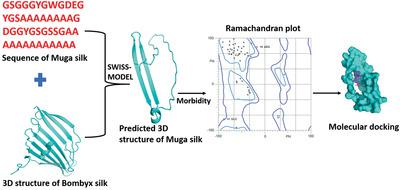当前位置:
X-MOL 学术
›
Biotechnol. Appl. Bioc.
›
论文详情
Our official English website, www.x-mol.net, welcomes your
feedback! (Note: you will need to create a separate account there.)
Homology modeling and molecular docking study of biogenic Muga silk nanoparticles as putative drug-binding system
Biotechnology and Applied Biochemistry ( IF 3.2 ) Pub Date : 2020-12-21 , DOI: 10.1002/bab.2088 Prithvi C Asapur 1 , Purushottam D Sahare 2 , Santosh Kumar Mahapatra 3 , Indrani Banerjee 1
Biotechnology and Applied Biochemistry ( IF 3.2 ) Pub Date : 2020-12-21 , DOI: 10.1002/bab.2088 Prithvi C Asapur 1 , Purushottam D Sahare 2 , Santosh Kumar Mahapatra 3 , Indrani Banerjee 1
Affiliation

|
The recent emergence of natural biopolymers as drug delivery vehicles is attributed to their biodegradability and less systemic toxicity. Muga silk nanoparticles were prepared using microwave radiolysis method and were characterized by Fourier transform infrared spectroscopy, circular dichroism, X-ray diffraction and transmission electron microscopy. To find the applicability in the drug delivery system of these nanoparticle and to know the binding site(s), a computational study was carried out. The structure of the Muga protein is predicted using homology modeling, which is further used for molecular docking. The in silico molecular docking between the Muga silk nanoparticles and three United States Food and Drug Administration-approved model drugs of doxorubicin, remdesivir and dexamethasone was performed. The binding capabilities and binding energy of the Muga silk proteins with these drugs are determined. The basic idea of the active site and the residues involved in the binding of the drugs/ligands is also studied. Doxorubicin showed the highest binding affinity of −8.7 kcal/mol and that of the remdesivir and dexamethasone are found to be −7.2 and −7.9 kcal/mol, respectively. Such high binding affinity(ies) would help for slow drug release kinetics and the other two drugs can be loaded when the requirement is for sustained drug release. The data were also validated using the UV–vis. spectroscopy.
中文翻译:

生物源Muga丝纳米粒子作为推定的药物结合系统的同源性建模和分子对接研究
最近出现的天然生物聚合物作为药物输送载体归因于它们的可生物降解性和较低的全身毒性。采用微波辐解法制备穆加丝纳米粒子,并通过傅里叶变换红外光谱、圆二色性、X射线衍射和透射电子显微镜对其进行表征。为了找到这些纳米颗粒在药物输送系统中的适用性并了解结合位点,进行了计算研究。使用同源性模型预测 Muga 蛋白的结构,进一步用于分子对接。计算机_进行了 Muga 丝纳米粒子与美国食品和药物管理局批准的三种多柔比星、瑞德西韦和地塞米松模型药物之间的分子对接。测定了 Muga 丝蛋白与这些药物的结合能力和结合能。还研究了参与药物/配体结合的活性位点和残基的基本概念。多柔比星的结合亲和力最高,为 -8.7 kcal/mol,瑞德西韦和地塞米松的结合亲和力分别为 -7.2 和 -7.9 kcal/mol。如此高的结合亲和力将有助于缓慢的药物释放动力学,并且当需要持续药物释放时可以加载其他两种药物。还使用 UV-vis 验证了数据。光谱学。
更新日期:2020-12-21
中文翻译:

生物源Muga丝纳米粒子作为推定的药物结合系统的同源性建模和分子对接研究
最近出现的天然生物聚合物作为药物输送载体归因于它们的可生物降解性和较低的全身毒性。采用微波辐解法制备穆加丝纳米粒子,并通过傅里叶变换红外光谱、圆二色性、X射线衍射和透射电子显微镜对其进行表征。为了找到这些纳米颗粒在药物输送系统中的适用性并了解结合位点,进行了计算研究。使用同源性模型预测 Muga 蛋白的结构,进一步用于分子对接。计算机_进行了 Muga 丝纳米粒子与美国食品和药物管理局批准的三种多柔比星、瑞德西韦和地塞米松模型药物之间的分子对接。测定了 Muga 丝蛋白与这些药物的结合能力和结合能。还研究了参与药物/配体结合的活性位点和残基的基本概念。多柔比星的结合亲和力最高,为 -8.7 kcal/mol,瑞德西韦和地塞米松的结合亲和力分别为 -7.2 和 -7.9 kcal/mol。如此高的结合亲和力将有助于缓慢的药物释放动力学,并且当需要持续药物释放时可以加载其他两种药物。还使用 UV-vis 验证了数据。光谱学。











































 京公网安备 11010802027423号
京公网安备 11010802027423号